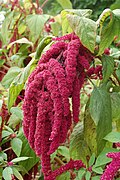Amaranthus caudatus
Amaranthus_caudatus[edit]
-
Amaranthus caudatus in bloom
-
Amaranthus caudatus plant
Amaranthus caudatus[edit]
Amaranthus caudatus, commonly known as love-lies-bleeding, is a species of flowering plant in the Amaranthaceae family. It is native to the Andes region of South America, where it has been cultivated for thousands of years as a grain crop. The plant is notable for its striking, drooping inflorescences and its nutritional seeds.
Description[edit]
Amaranthus caudatus is an annual plant that can grow to a height of 1 to 2 meters. The plant has broad, alternate leaves that are ovate to rhomboid in shape. The most distinctive feature of A. caudatus is its long, tassel-like inflorescences, which can be red, purple, or green. These inflorescences can reach lengths of up to 50 cm and hang down from the plant, giving it a unique appearance.
The seeds of Amaranthus caudatus are small, lens-shaped, and typically pale in color. They are rich in protein and essential amino acids, making them a valuable food source.
Cultivation[edit]
Amaranthus caudatus is cultivated primarily for its seeds, which are used as a pseudocereal. It is grown in a variety of climates, from temperate to tropical regions. The plant prefers well-drained soil and full sun exposure. It is relatively drought-tolerant and can be grown in areas with low rainfall.
The seeds are harvested when the inflorescences begin to dry and the seeds can be easily threshed. The seeds are then cleaned and can be used in a variety of culinary applications.
Uses[edit]
The seeds of Amaranthus caudatus are highly nutritious and are used in a variety of dishes. They can be ground into flour, popped like popcorn, or cooked whole. The seeds are gluten-free, making them suitable for people with celiac disease or gluten intolerance.
In addition to its use as a food source, A. caudatus is also grown as an ornamental plant due to its striking appearance. The plant's vibrant inflorescences make it a popular choice for gardens and floral arrangements.
Nutritional Value[edit]
Amaranthus caudatus seeds are rich in protein, containing about 13-15% protein by weight. They are also a good source of lysine, an essential amino acid that is often lacking in other grains. The seeds contain a variety of vitamins and minerals, including calcium, iron, and magnesium.
Cultural Significance[edit]
In the Andes, Amaranthus caudatus has been an important crop for indigenous peoples for centuries. It is often associated with traditional festivals and rituals. The plant is sometimes referred to as "kiwicha" in Quechua, the language of the Inca Empire.
Related pages[edit]
Ad. Transform your life with W8MD's Budget GLP-1 injections from $75


W8MD offers a medical weight loss program to lose weight in Philadelphia. Our physician-supervised medical weight loss provides:
- Weight loss injections in NYC (generic and brand names):
- Zepbound / Mounjaro, Wegovy / Ozempic, Saxenda
- Most insurances accepted or discounted self-pay rates. We will obtain insurance prior authorizations if needed.
- Generic GLP1 weight loss injections from $75 for the starting dose.
- Also offer prescription weight loss medications including Phentermine, Qsymia, Diethylpropion, Contrave etc.
NYC weight loss doctor appointmentsNYC weight loss doctor appointments
Start your NYC weight loss journey today at our NYC medical weight loss and Philadelphia medical weight loss clinics.
- Call 718-946-5500 to lose weight in NYC or for medical weight loss in Philadelphia 215-676-2334.
- Tags:NYC medical weight loss, Philadelphia lose weight Zepbound NYC, Budget GLP1 weight loss injections, Wegovy Philadelphia, Wegovy NYC, Philadelphia medical weight loss, Brookly weight loss and Wegovy NYC
|
WikiMD's Wellness Encyclopedia |
| Let Food Be Thy Medicine Medicine Thy Food - Hippocrates |
Medical Disclaimer: WikiMD is not a substitute for professional medical advice. The information on WikiMD is provided as an information resource only, may be incorrect, outdated or misleading, and is not to be used or relied on for any diagnostic or treatment purposes. Please consult your health care provider before making any healthcare decisions or for guidance about a specific medical condition. WikiMD expressly disclaims responsibility, and shall have no liability, for any damages, loss, injury, or liability whatsoever suffered as a result of your reliance on the information contained in this site. By visiting this site you agree to the foregoing terms and conditions, which may from time to time be changed or supplemented by WikiMD. If you do not agree to the foregoing terms and conditions, you should not enter or use this site. See full disclaimer.
Credits:Most images are courtesy of Wikimedia commons, and templates, categories Wikipedia, licensed under CC BY SA or similar.
Translate this page: - East Asian
中文,
日本,
한국어,
South Asian
हिन्दी,
தமிழ்,
తెలుగు,
Urdu,
ಕನ್ನಡ,
Southeast Asian
Indonesian,
Vietnamese,
Thai,
မြန်မာဘာသာ,
বাংলা
European
español,
Deutsch,
français,
Greek,
português do Brasil,
polski,
română,
русский,
Nederlands,
norsk,
svenska,
suomi,
Italian
Middle Eastern & African
عربى,
Turkish,
Persian,
Hebrew,
Afrikaans,
isiZulu,
Kiswahili,
Other
Bulgarian,
Hungarian,
Czech,
Swedish,
മലയാളം,
मराठी,
ਪੰਜਾਬੀ,
ગુજરાતી,
Portuguese,
Ukrainian

